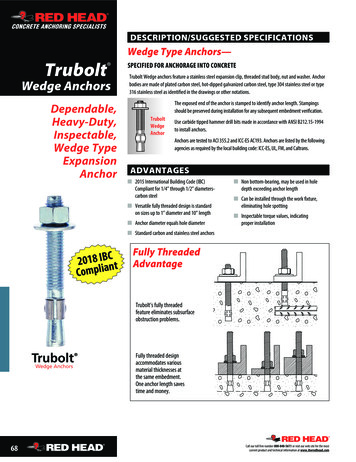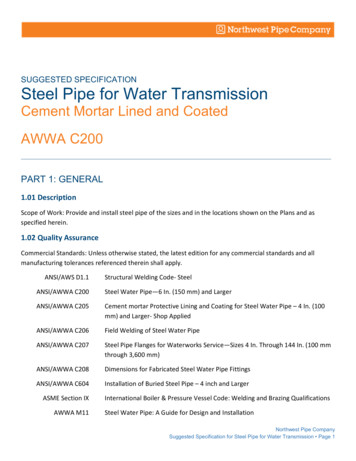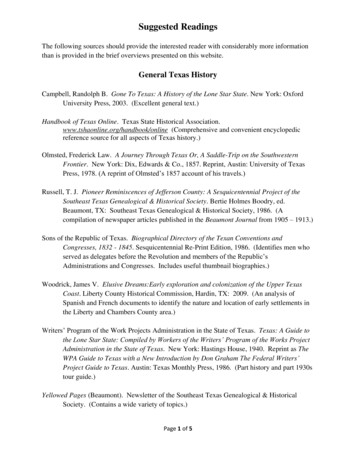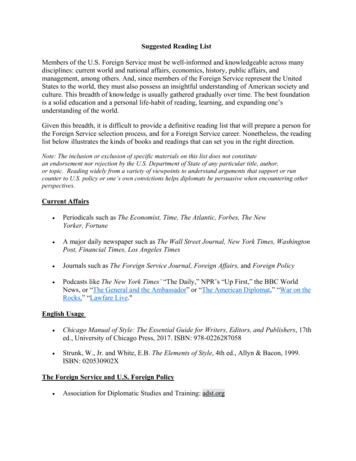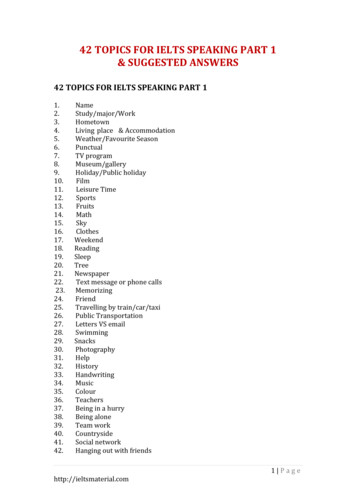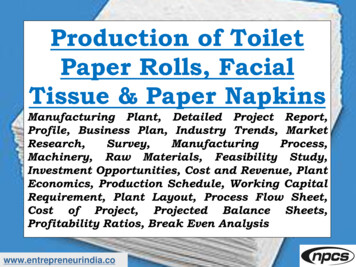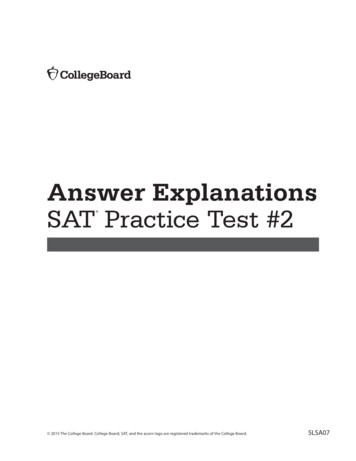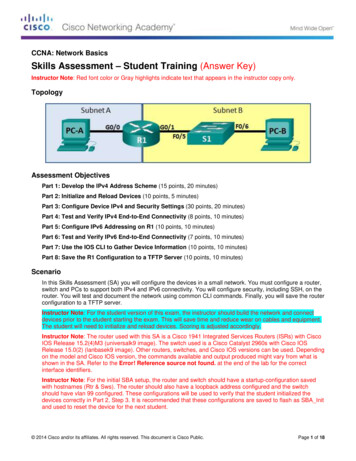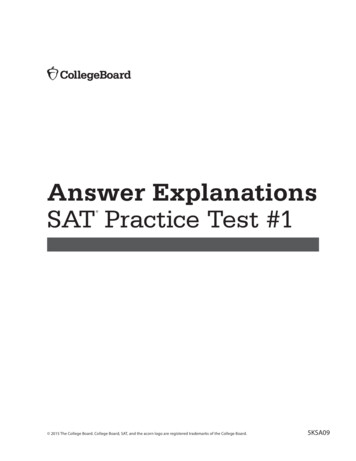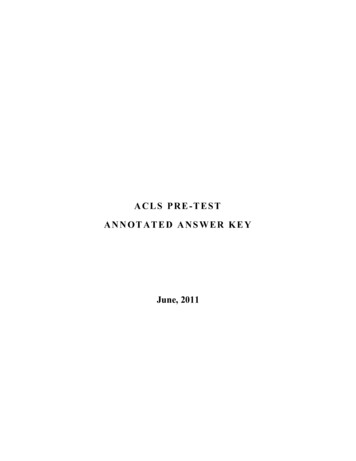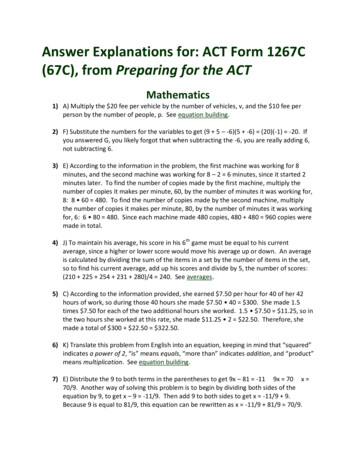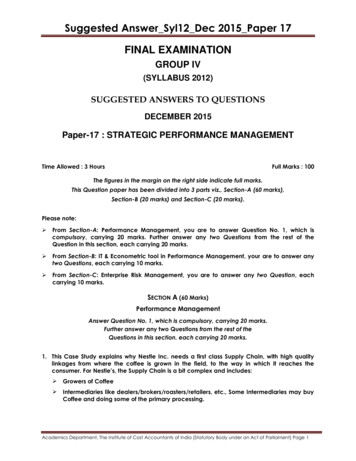
Transcription
Suggested Answer Syl12 Dec 2015 Paper 17FINAL EXAMINATIONGROUP IV(SYLLABUS 2012)SUGGESTED ANSWERS TO QUESTIONSDECEMBER 2015Paper-17 : STRATEGIC PERFORMANCE MANAGEMENTTime Allowed : 3 HoursFull Marks : 100The figures in the margin on the right side indicate full marks.This Question paper has been divided into 3 parts viz., Section-A (60 marks),Section-B (20 marks) and Section-C (20 marks).Please note: From Section-A: Performance Management, you are to answer Question No. 1, which iscompulsory, carrying 20 marks. Further answer any two Questions from the rest of theQuestion in this section, each carrying 20 marks. From Section-B: IT & Econometric tool in Performance Management, your are to answer anytwo Questions, each carrying 10 marks. From Section-C: Enterprise Risk Management, you are to answer any two Question, eachcarrying 10 marks.SECTION A (60 Marks)Performance ManagementAnswer Question No. 1, which is compulsory, carrying 20 marks.Further answer any two Questions from the rest of theQuestions in this section, each carrying 20 marks.1. This Case Study explains why Nestle Inc. needs a first class Supply Chain, with high qualitylinkages from where the coffee is grown in the field, to the way in which it reaches theconsumer. For Nestle‟s, the Supply Chain is a bit complex and includes: Growers of Coffee Intermediaries like dealers/brokers/roasters/retailers, etc., Some Intermediaries may buyCoffee and doing some of the primary processing.Academics Department, The Institute of Cost Accountants of India (Statutory Body under an Act of Parliament) Page 1
Suggested Answer Syl12 Dec 2015 Paper 17 Growing and processing of Coffee. This includes activities like coffee picking, drying andhulling sorting, grading & picking. Price-Balancing Supply and Demand: Coffee prices are determined on day-to-day basison the world commodity markets in London and New York. The price of Coffee isdetermined by the relationship between the amount of Coffee available to be sold(Supply) and the amount which the company would like to buy (demand). If there ismore Coffee available than what the company would desire to buy at current prices, theprices will fall. The market, thus, ultimately determines the price that the farmer receives. Nestle‟s Trading Methods: Nestle is a pioneer in purchasing Coffee direct from growers. Agrowing % of the company‟s Coffee is bought direct from the producer and it is now oneof the world‟s largest direct purchasers. In Countries, where this is not possible, Nestleoperates in a way that takes it as close to the growers as possible. Buying from dealers: In countries like UK, it is impossible for Nestle to buy from thehundreds of thousands of farmers, who ultimately supply the Company and so the coffeeis bought from dealers, using the international market.Conclusion: Creating wonderful cups of Coffee is not only Nestle‟s business, it is the businessof everyone involved in the Supply Chain. It is in everyone‟s interest the farmers‟ and Nestle‟s– that farmers receive a fair income from their Coffee. This ensures that they will continue togrow Coffee and to invest in increasing their yield and quality and this in turn, guarantees thesupply of quality Coffee, which companies like Nestle require.In the context of the above case study, answer the following questions:(i) What is Supply Chain Management? Explain clearly its basic concept?(ii) What are the basic objectives of a Supply Chain?(iii) State the way Nestle Inc., manages its Supply Chain?8 5 7 20Answer:1. (i)Supply Chain Management (SCM) is the active management of Supply Chain activities tomaximize customer value and achieve a sustainable Competitive Advantage.A Supply Chain is a network of facilities and distribution options that performs the functions ofProcurement of materials, transformation of these materials into intermediate and finished goodsand the distribution of these finished goods to the customers. Supply Chain exists in both Serviceand Manufacturing Organizations. The complexity of the chain may vary greatly from Industry toIndustry and from firm to firm.The concept of Supply Chain Management (SCM) is based on the core idea that every productthat reaches an end user represents the cumulative effort of multiple organizations andcollectively referred to as Supply Chain.Supply Chain Management (SCM) represents a conscious effort by the Supply Chain firms todevelop and run Supply Chains in the most effective and efficient ways possible.In 1980s companies discovered new manufacturing technologies and strategies that allowedthem to reduce costs and compete better in different markets. Strategies like JIT manufacturing,Lean Manufacturing, TQM etc., became very popular and vast amounts of resources wereAcademics Department, The Institute of Cost Accountants of India (Statutory Body under an Act of Parliament) Page 2
Suggested Answer Syl12 Dec 2015 Paper 17invested in implementing these strategies. Many companies have reduced manufacturing costto the barest minimum.Many companies are discovering that effective SCM is the next step that must be taken toincrease Profit and market share.SCM is a strategy/mechanism, through which different functions can be integrated.SCM is not a new innovation in management philosophy. Rather it existed since the time ofNapoleon, as he commended once “Army marches on its stomach.” He did not explain hisstatement but the inner meaning is unquestionable i.e., to make a strategy successful, it shouldhave a strong line of supply be it food, clothes, arms or anything else.Thus, SCM is the management of upstream and downstream value-added flow of materials, finalgoods and related information among Suppliers, Company, Re-Sellers and final customers. It is asystematic and strategic co-ordination of the traditional business functions with a view toimproving the long-term performance of the company. It encompasses the planning andmanagement of all activities involved in Sourcing, Procurement, Conversions and LogisticManagement.In a nutshell, SCM implies all such activities by which the final product is delivered in the hands ofcustomers.Logistics is the logical way of transportation in a timely way so that Production and Distributionare not hampered.But in SCM, we take into account all the aspects of the Product like: Sales demand analysisProduction PlanningProcurement of Raw-MaterialWare-housingProduction Process/ConversionOperations ManagementLogistics ManagementDistribution of Finished goods to the ultimate customers in a well-synchronized manner.One Supplier is dependent on the other‟s service and the very other is depending on some otherunit‟s performance. If one unit of the chain does not meet the demand of the very next levelproducer, members of the whole chain face problems. That is the importance of Supply Chain.1. (ii) Objectives of Supply Chain:The following are the basic objectives of Supply Chain: Maximization of the overall value createdTakes into consideration that every facility has an impact on cost and should play a role inmaking the product conform to customer requirements: from Supplier and manufacturingfacilities through warehouses and distribution centres to retailers and stores.SCM should be efficient and cost-effective across the entire system; total system wide costsfrom transportation and distribution to inventories of R/M, WIP and finished goods are to beminimized.Academics Department, The Institute of Cost Accountants of India (Statutory Body under an Act of Parliament) Page 3
Suggested Answer Syl12 Dec 2015 Paper 17 SCM revolves around efficient integration of Suppliers, Manufacturers, Warehouses andStores; it encompasses the firm‟s activities at many levels, from the strategies level throughthe tactical to the operational level.Increase the Supply Chain Profitability.Balancing the Demand and the Supply.1. (iii) Nestle‟s Supply Chain:Nestle‟s the Supply Chain is a bit complex and includes: Growers of CoffeeIntermediaries like dealers/brokers/roasters/retailers, etc., Some Intermediaries may buyCoffee and doing some of the primary processing.Growing and processing of Coffee. This includes activities like Coffee picking, Drying andhulling, sorting, grading & picking.Price-Balancing Supply and Demand: Coffee prices are determined on day-to-day basis onthe world commodity markets in London and New York. The price of Coffee is determined bythe relationship between the amount of Coffee available to be sold (Supply) and theamount which the company would like to buy (demand). If there is more Coffee availablethan what the company would desire to buy at current prices, the prices will fall. The market,thus, ultimately, determines the price that the farmer receives.Nestle‟s Trading Methods: Nestle is a pioneer in purchasing Coffee direct from growers. Agrowing % of the company‟s Coffee is bought direct from the producer and it is now one ofthe world‟s largest direct purchasers. in Countries, where this is not possible, Nestle operatesin a way that takes it as close to the growers as possible.Buying from dealers: In countries like UK, it is impossible for Nestle to buy from the hundreds ofthousands of farmers, who ultimately supply the Company and so the Coffee is bought fromdealers, using the international market.2. (a) Krish of India presently operates its plant at 80% of the normal capacity of manufacture aproduct only to meet the demand of Government of India under a rate contract. Hesupplies the product for 4,00,000 and earns a profit margin of 20% on sales realizations.Direct Cost per unit is constant.The indirect costs as per his budget projection are:Indirect Costs20,000 units22,500 units25,000 units(80% capacity)(90% capacity)(100% capacity)( )( )( ,50045,000Fixed80,00080,00080,000He received an export order for the product equal to 20% of its present operations.Additional packing charges on this order will be 1,000.As a Management Accountant, Calculate the price to be quoted for the export order soas to give his a profit margin of 10% on the export price.10(b) What is „competitive intelligence‟? Discuss the role of Management Accountant incompetitive intelligence process?10Answer:Academics Department, The Institute of Cost Accountants of India (Statutory Body under an Act of Parliament) Page 4
Suggested Answer Syl12 Dec 2015 Paper 172. (a)Computation of Direct Cost:Selling PriceLess: Profit MarginTotal CostLess: Indirect CostsDirect CostPer unit ( )20416106 4,00,000 20,000 units@ 20% on selling price i.e., on 20 2,00,000 20,000 unitsStatement showing Differential Cost for production of additional 4,000 units:Production UnitsDirect Cost @ 6 per unitIndirect Costs:Variable Cost @ 4 per unitSemi-VariableFixedTotal CostsPresent20,000( )1,20,000Proposed24,000( )1,44,000Differential4,000( 03,65,00016,0004,0001,00045,000Quotation for the Export Order (with a desired profit of 10% on Export Price) Differential Cost45,000Add: Profit (10% of Export Price or 1/9 of Cost)5,000Export Price to be quoted50,000Export Price to be quoted per unit 50,000 4,000 units 12.50.2. (b)Competitive Intelligence (CI): is the action of defining, gathering, analyzing and distributingIntelligence about products, customers, competitors and any aspect of environment needed tosupport executives and managers in making strategic decisions for an organizations. It is anethical and legal business practice, as opposed to industrial espionage, which is illegal.In CI, the focus is on the external business environment, incorporating external competitive andmarket forces into Strategic Planning. Further, the thrust in CI is to gather information, thenconvert it to intelligence and then to utilize it in business decision-making.It essentially means understanding and learning what is happening in the world outside yourbusiness, so as to be as competitive as possible. It means learning as much as possible as soon aspossible about your industry in general and your competitors. In short, CI empowers you toanticipate and face challenges head on.Role of Management Accountant in Competitive Intelligence Process:CI is a process of gathering data, creating information and making decisions. ManagementAccountants gather data, assimilate data into information and make decisions based uponinformation, frequently with their management counterparts.Academics Department, The Institute of Cost Accountants of India (Statutory Body under an Act of Parliament) Page 5
Suggested Answer Syl12 Dec 2015 Paper 17Management Accountants may be actively involved in introducing a Competitive IntelligenceProcess in several ways, as indicated below: Indentifying the need for a new or improved competitive Intelligence process.Educating the top management and other senior managers about that need.Developing a plan along with cross-functional team members for designing, developing andimplementing the new, improved Competitive Intelligence Practice, including its underlyingarchitectures.Identifying the appropriate goods and techniques for conducing competitor analysis.Providing financial input, analysis and expertise to the Competitive Intelligence effort.Ensuring that the CI efforts are ties to the firm‟s goals, strategies, objectives and internalprocesses, as appropriate.Continually assessing the new, improved CI Process and its implications for the organizationand continually improving the process.CI may also be viewed as a Competitive Audit, a concept that the Management Accountantsare familiar with. Management Accountants‟ training and experience make them well suited tothe requirements, of the CI process.3. (a) Timma Ltd., has the capacity of production of 80,000 units and presently sells 20,000 unitsat 50 each. The demand is sensitive to Selling Price and it has been observed that forevery reduction of 10 in the Selling P
Supply Chain Management (SCM) is the active management of Supply Chain activities to maximize customer value and achieve a sustainable Competitive Advantage. A Supply Chain is a network of facilities and distribution options that performs the functions of Procurement of materials, transformation of these materials into intermediate and finished goods and the distribution of these finished .
